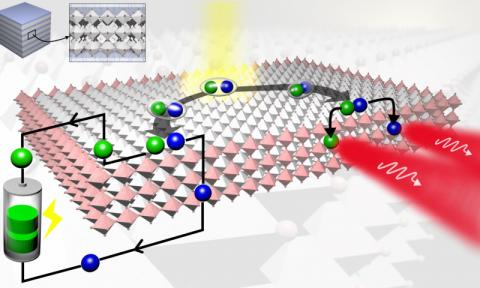Researchers at Los Alamos National Laboratory and their partners are creating innovative 2D layered hybrid perovskites that they say can allow greater freedom in designing and fabricating efficient optoelectronic devices. Industrial and consumer applications could include low cost solar cells, LEDs, laser diodes, detectors, and other nano-optoelectronic devices.

They explain that these materials are layered compounds, or a stack of 2D layers of perovskites with nanometer thickness (like a stack of sheets), and the 2D perovskite layers are separated by thin organic layers. "This work could overturn conventional wisdom on the limitations of device designs based on layered perovskites", the team says.
The 2D films have an out-of-plane orientation so that uninhibited charge transport occurs through the perovskite layers in planar devices. At the edges of the perovskite layers, the new research discovered "layer-edge-states," which are key to both high efficiency of solar cells (>12 percent) and high fluorescence efficiency for LEDs. The spontaneous conversion of excitons (bound electron-hole pairs) to free carriers via these layer-edge states appears to be the key to improving the photovoltaic and light-emitting thin-film layered materials.
The team investigated both photophysical and optoelectronic properties of phase-pure homogenous 2D perovskites. They were able to show that thin films have an intrinsic mechanism for dissociation of the strongly bound electron-hole pairs (excitons) to long-lived free-carriers provided by lower energy states at the edges of the layered perovskites.
Moreover, once carriers are trapped in these edge states, they remain protected and do not lose their energy via non-radiative processes. They can contribute to photocurrent in a photovoltaic (PV) device or radiatively recombine efficiently for light-emission applications. "These materials are quantum hybrid materials, possessing physical properties of both organic semiconductors and inorganic semiconducting quantum wells. We are just beginning to understand the interplay of the organic and inorganic components in 2D perovskites and this result underpins how unique properties can arise from competing physical properties," said the Los Alamos team.
"These results address a long-standing problem not just for the perovskite family, but relevant to a large group of materials where edges and surface states generally degrade the optoelectronic properties, which can now be chemically designed and engineered to achieve efficient flow of charge and energy leading to high-efficiency optoelectronic devices," said leader of the perovskite program in the Material Synthesis and Integrated devices group at Los Alamos.

